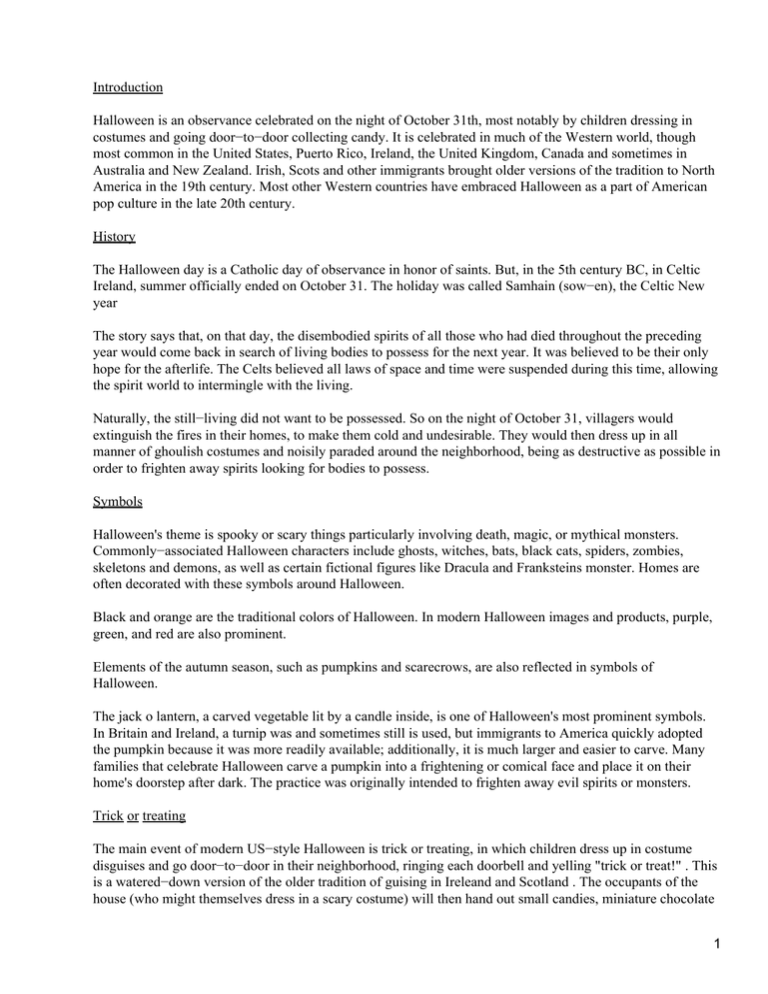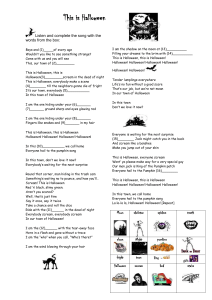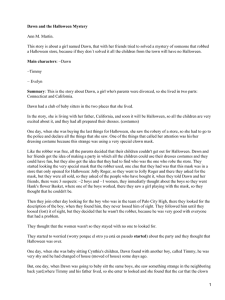Introduction Halloween is an observance celebrated on the night of October...
Anuncio

Introduction Halloween is an observance celebrated on the night of October 31th, most notably by children dressing in costumes and going door−to−door collecting candy. It is celebrated in much of the Western world, though most common in the United States, Puerto Rico, Ireland, the United Kingdom, Canada and sometimes in Australia and New Zealand. Irish, Scots and other immigrants brought older versions of the tradition to North America in the 19th century. Most other Western countries have embraced Halloween as a part of American pop culture in the late 20th century. History The Halloween day is a Catholic day of observance in honor of saints. But, in the 5th century BC, in Celtic Ireland, summer officially ended on October 31. The holiday was called Samhain (sow−en), the Celtic New year The story says that, on that day, the disembodied spirits of all those who had died throughout the preceding year would come back in search of living bodies to possess for the next year. It was believed to be their only hope for the afterlife. The Celts believed all laws of space and time were suspended during this time, allowing the spirit world to intermingle with the living. Naturally, the still−living did not want to be possessed. So on the night of October 31, villagers would extinguish the fires in their homes, to make them cold and undesirable. They would then dress up in all manner of ghoulish costumes and noisily paraded around the neighborhood, being as destructive as possible in order to frighten away spirits looking for bodies to possess. Symbols Halloween's theme is spooky or scary things particularly involving death, magic, or mythical monsters. Commonly−associated Halloween characters include ghosts, witches, bats, black cats, spiders, zombies, skeletons and demons, as well as certain fictional figures like Dracula and Franksteins monster. Homes are often decorated with these symbols around Halloween. Black and orange are the traditional colors of Halloween. In modern Halloween images and products, purple, green, and red are also prominent. Elements of the autumn season, such as pumpkins and scarecrows, are also reflected in symbols of Halloween. The jack o lantern, a carved vegetable lit by a candle inside, is one of Halloween's most prominent symbols. In Britain and Ireland, a turnip was and sometimes still is used, but immigrants to America quickly adopted the pumpkin because it was more readily available; additionally, it is much larger and easier to carve. Many families that celebrate Halloween carve a pumpkin into a frightening or comical face and place it on their home's doorstep after dark. The practice was originally intended to frighten away evil spirits or monsters. Trick or treating The main event of modern US−style Halloween is trick or treating, in which children dress up in costume disguises and go door−to−door in their neighborhood, ringing each doorbell and yelling "trick or treat!" . This is a watered−down version of the older tradition of guising in Ireleand and Scotland . The occupants of the house (who might themselves dress in a scary costume) will then hand out small candies, miniature chocolate 1 bars or other treats. Some American homes will use sound effects and fog machines to help set a spooky mood. Other house decoration themes (that are less scary) are used to entertain younger visitors. Children can often accumulate many treats on Halloween night, filling up entire pillow cases or shopping bags. In Ireleand, great bonfires were lit throughout the breadth of the land. Young children in their guises were gladly received by the neighbors with some 'fruit, apples and nuts' for the 'Halloween Party', whilst older male siblings played innocent pranks on bewildered victims. In Scotland, children or guisers are more likely to recite "The sky is blue, the grass is green, may we have our Hallowe'en" instead of "trick or treat!". They visit neighbours in groups and must impress the members of the houses they visit with a song, poem, trick, joke or dance in order to earn their treats. Traditionally, nuts, oranges, apples and dried fruit were offered, though sometimes children would also earn a small amount of cash, usually a sixpence. Very small children often take part, for whom the experience of performing can be more terrifying than the ghosties outside. Tricks play less of a role in modern Halloween, though Halloween night is often marked by vandalism such as soaping windows, egging houses or stringing toilet paper through trees. Before indoor plumbing was so widespread, tipping over or displacing outhouses was a popular form of intimidation. Foods Because the holiday comes in the wake of the annual apple harvest, Candy Apples are a common treat at Halloween. They are made by rolling whole apples in a sticky sugar syrup, and sometimes then rolling them in nuts. At one time candy apples were a common treat given to children, but this practice rapidly waned after widespread rumors that some individuals were embedding items like pins and razor blades in the apples that they would pass out to children. While there is evidence of such incidents occurring they are very rare and have never resulted in any serious injuries. Nonetheless, many parents were under the assumption that the practice was common. At the peak of this hysteria, some hospitals were offering to x−ray children's Halloween haul at no cost in order to look for such items. Almost all of the very few Halloween candy poisoning incidents on record involved parents who poisoned their own children's candy, while there are occasional reports of kids sticking needles in their own candy more in an effort to get attention than cause any harm. Yet the paranoia has continued unabated mostly because of the news media's misinformation and tendency to exaggerate threats − especially when children are involved. A Halloween custom which has survived unchanged to this day in Ireland is the bakin) of a barmbrack . This is a light fruit cake into which a plain ring is placed before baking. It is said that whoever finds this ring will find his or her true love during the following year. Other foods associated with Halloween: Candy corn Hot apple cider Roasted pumpkin seeds Individually wrapped pieces of small candy Customs What sets Halloween costumes apart from costumes for other celebrations or days of dressing up is that they are often designed to be gruesome or scary. Popular monsters of legend or fiction are regular themes for 2 Halloween costumes, as are pop culture figures like presidents, film or television characters. Some of the most common and popular Halloween costumes are: Ghost Vampire Frankenstein's Monster Witch Conclusion We can conclude that the Halloween tradition was founded in a mystic time, where none really knew if there was a life beyond death, the mith said that the spirits of the people that died in the thirthieth day rised from the grave and tried to possess other bodies, so they used costumes to scare the spirits and turned off the fire to avoid the ghosts. In this age, the tradition of cult and fear has become something much more light, now is a festivity for the children, they still wear costumes but only for fun, not to scare ghosts, and they don't turn off the lights, they ask for candy, so they can remember it with joy in the future 3



